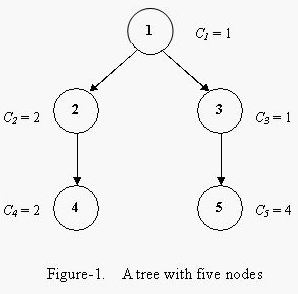Color a Tree
| Time Limit: 1000MS |
|
Memory Limit: 30000K |
| Total Submissions: 2095 |
|
Accepted: 564 |
Description
Bob is very interested in the data structure of a tree. A tree is
a directed graph in which a special node is singled out, called the "root" of
the tree, and there is a unique path from the root to each of the other nodes.
Bob intends to color all the nodes of a tree with a pen. A tree has N
nodes, these nodes are numbered 1, 2, ..., N. Suppose coloring a node takes 1
unit of time, and after finishing coloring one node, he is allowed to color
another. Additionally, he is allowed to color a node only when its father node
has been colored. Obviously, Bob is only allowed to color the root in the first
try.
Each node has a "coloring cost factor", Ci. The coloring cost of
each node depends both on Ci and the time at which Bob finishes the coloring of
this node. At the beginning, the time is set to 0. If the finishing time of
coloring node i is Fi, then the coloring cost of node i is Ci * Fi.
For
example, a tree with five nodes is shown in Figure-1. The coloring cost factors
of each node are 1, 2, 1, 2 and 4. Bob can color the tree in the order 1, 3, 5,
2, 4, with the minimum total coloring cost of 33.

Given a
tree and the coloring cost factor of each node, please help Bob to find the
minimum possible total coloring cost for coloring all the nodes.
Input
The input consists of several test cases. The first line of each
case contains two integers N and R (1 <= N <= 1000, 1 <= R <= N),
where N is the number of nodes in the tree and R is the node number of the root
node. The second line contains N integers, the i-th of which is Ci (1 <= Ci
<= 500), the coloring cost factor of node i. Each of the next N-1 lines
contains two space-separated node numbers V1 and V2, which are the endpoints of
an edge in the tree, denoting that V1 is the father node of V2. No edge will be
listed twice, and all edges will be listed.
A test case of N = 0 and R =
0 indicates the end of input, and should not be processed.
Output
For each test case, output a line containing the minimum total
coloring cost required for Bob to color all the nodes.
Sample Input
5 1
1 2 1 2 4
1 2
1 3
2 4
3 5
0 0
Sample Output
33
题目大意:
给你一个有N个节点的树,每个节点都有一个权值。现在你要给这棵树染色,染色的规则是:
(1)根节点可以随时给它染色
(2)若要给某个节点染色,必须已经给它的父节点染好了色
每次染色的代价是(I*VAL[J])I代表第几次染色。求最小代价。
输入第一行两个整数N M代表一共有N个节点点,根接点是M。
第二行N个整数代表每个节点的权值。
以下N-1行每行两个整数A B代表A是B的父亲。
解析:
我是看报告写的,看报告吧……这个就是所谓的恶心题。
我们这样来思考,在染色了Pa(Max)之后,就要马上进行Max结点染色。合并之后成为一个Union结点,他的权值是二者的和,而将Union节点染色的时间为2。同时Max和Pa(Max)的所有儿子均为Union的儿子,这样就根据题意完成了合并Pa(max)和Max两个结点的工作。由于合并产生了染色需要时间的关系,下面对模型进行扩充:每个结点有一个权值Ci,和一个染色所需要的时间Si,而且每个结点还有一个生成序列,表示依次是哪些结点合并而成。所以我们的贪心思想也有所变化,尽量让Ci/Si比值最大的节点先染色。这很好理解,如果将合并了的结点拆开来看,事实上可以认为是Si个权值为Ci/Si的结点。根据合并的方式,我们得到了一个算法:
1. 令所有节点S值均为1,每个节点生成序列中仅有一个元素,即为它本身。
2. 若树中只剩一个结点,则输出这个这个结点的生成序列。
3. 取出Ci/Si值最大的非根结点Max。
4. 将Max和其父亲合并,新合并出的结点Union的各个参数为:CunionßCMax+CPa(max),SUnionßSMax+SPa(Max),同时Union的生成序列为Pa(Max)的生成序列与Max的生成序列连接而成。
5. 重复2~4步。
我们来分析一下整个算法的时间复杂度,维护所有结点集合,快速找出权值最大的非根结点可以使用二叉堆。而对结点进行和并可以使用并查集。其中维护堆总时间复杂度为O(Nlog2N),而并查集时间复杂度为O(N*a(n)),所以总时间复杂度为O(Nlog2N)。
很恶心,我看完题目之后只能想到是个贪心,因为树归不能传递两个子树分别的权值,所以有后效性。可是怎么都想不到是这样贪的……
(转载于:http://hi.baidu.com/gugugupan/blog/item/710628f56cad3268ddc474f9.html)
